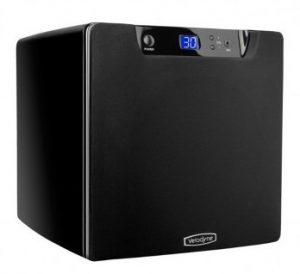
Velodyne Optimum subwoofer with remote control of volume, room matching and phase
Most rooms need subwoofers
If we demonstrate with subwoofers, even with big speakers, then turn them off the instant reaction is, ‘It’s gone flat! It’s lost interest and ambience.’
Mentioning sub-woofers to customers can be a real turn-off! It’s the bad experiences that make people say they don’t need or even like deep bass, so why have a subwoofer?
‘Why do I want a sub when the music I play has little bass in it?’ Or even worse: ‘All the subwoofers I’ve heard just add more boom! So what’s the point?!’
Controlling the room is the point. But like absolutely everything else in audio, it depends how you do it.
It’s sad to hear how many systems are spoiled by poor bass – slow, boomy, one-note, overhanging bass. Adding sub-woofers is often the answer!
See also our advice about speaker positioning under Tips – crucial.
Reveal space with bass
Recordings contain frequencies – harmonics of the fundamental note – that extend above and below our normal hearing range. If you don’t reproduce the deep harmonics cleanly, music in the audible range loses presence, ambience and pace.
A good example would be a choir, just a choir with no organ accompaniment, in a big space. There will be a lot of inaudible air movement at very low frequencies that will modulate the voice frequencies. Reproducing those low frequencies will give the choir more ‘body’ and reveal the surrounding space.
For similar reasons a super-tweeter will supply the high harmonics which will properly define the leading edges of notes across the whole audio range, even the bass, for a tighter, crisper sound and better timing.
Sort out imaging first…
then everything else will fall into place.
Low frequencies below 30Hz easily excite rooms to boom, creating unreal bass that kills the rhythm and slows the pace, so it’s crucial to avoid over-driving the room into resonance.
First you re-position your main speakers to optimise the imaging, space and openness. Bass may well have gone light but now the solution: use the sub to produce controlled bass that blends with the room’s response! That requires “smart” subs – we like Velodyne – that can be matched to the room. They have controls that match the phase and roll off the deepest bass above your room’s mode to give a seamless, rhythmic, clean sound, top to bottom. No more boom.
Free, extended bass is revealed plus greater richness and ambience in the mid-range. Perhaps for the first time you will hear individual notes in a bass guitar run or a plucked double bass. That is musically immensely satisfying.
If you’ve read into this topic before you will probably have noticed that two subs are recommended where possible. We heartily endorse that advice, not because we sell another sub, but because two drive the room more evenly and the sound seems better focussed and stable, especially if you move off-axis.
Call us for advice.


